
Scydmaeninae are a subfamily of small beetles, commonly called ant-like stone beetles or scydmaenines. These beetles occur worldwide, and the subfamily includes some 4,500 species in about 80 genera. Established as a family, they were reduced in status to a subfamily of Staphylinidae in 2009

The ray spiders (Theridiosomatidae) are a family of spiders first described by Eugène Simon in 1881. They are most recognizable for their construction of cone-shaped webs.
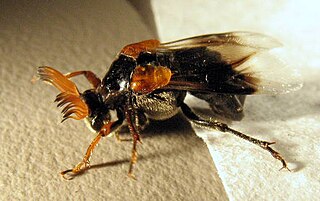
Ripiphoridae is a cosmopolitan family of some 450 described species of beetles sometimes called "wedge-shaped beetles". Ripiphoridae are unusual among beetle families in that many species are hypermetamorphic parasitoids, an attribute that they share with the Meloidae. Members of the family differ in their choice of hosts, but most attack various species of bees or wasps, while some others attack cockroaches.
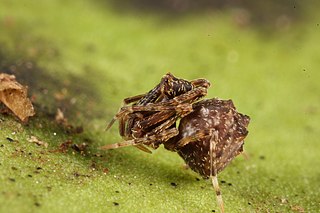
Archaeidae, also known as assassin spiders and pelican spiders, is a spider family with about ninety described species in five genera. It contains small spiders, ranging from 2 to 8 millimetres long, that prey exclusively on other spiders. They are unusual in that they have "necks", ranging from long and slender to short and fat. The name "pelican spider" refers to these elongated jaws and necks used to catch their prey. Living species of Archaeidae occur in South Africa, Madagascar and Australia, with the sister family Mecysmaucheniidae occurring in southern South America and New Zealand.
Ptychalaea is a fossil genus of very small, air-breathing land snails, terrestrial pulmonate gastropod molluscs in the family Gastrocoptidae.

The Baltic region is home to the largest known deposit of amber, called Baltic amber or succinite. It dates from 44 million years ago. It has been estimated that these forests created more than 100,000 tons of amber. Today, more than 90% of the world's amber comes from Kaliningrad Oblast of Russia. It is a major source of income for the region; the local Kaliningrad Amber Combine extracted 250 tonnes of it in 2014, 400 tonnes in 2015.

Inocelliidae is a small family of snakeflies containing 8 genera of which one is known only from fossils. They are commonly known as inocelliid snakeflies. The largest known species is Fibla carpenteri known from fossils found in baltic amber.
Propupa is an extinct genus of air-breathing land snail, a terrestrial pulmonate gastropod mollusk in the superfamily Pupilloidea. Propupa hoffeinsorum is the only species in the genus Propupa, and was described from a fossil found in Baltic amber in 2006.
Succinipatopsis is an extinct onychophoran genus known from Eocene-aged Baltic amber. The only known species described is S. balticus.

Micropterigoidea is the superfamily of "mandibulate archaic moths", all placed in the single family Micropterigidae, containing currently about twenty living genera. They are considered the most primitive extant lineage of lepidoptera. The name comes from the Greek for mikros, little and pterux, a wing. The fossil record of the group goes back to the Middle-Late Jurassic with the earliest known species being Auliepterix from the Karabastau Formation in Kazakhstan.
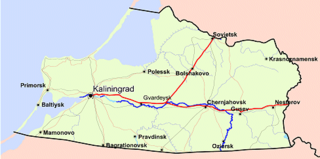
The Amber Coast is the name given to a coastal strip of the Baltic Sea in the northwest of Kaliningrad. In this area amber has been excavated since the mid-19th century and up to today in open-pit mining. Two deposits – Palmnikenskoe and Primorskoe, containing 80% of world amber reserves, were found near Yantarny on the Western coast of the Sambia Peninsula in 1948-1951’s.

Electrostephanus is an extinct genus of crown wasp in the hymenopteran family Stephanidae, and is the only genus placed in the subfamily Electrostephaninae. The genus contains four described species, E. brevicornis, E. neovenatus, E. janzeni, and E. petiolatus, placed in two subgenera E. (Electrostephanus) and E. (Electrostephanodes). Electrostephanus is known from several middle Eocene fossils which have been found in Europe.

Elephantomyia (Elephantomyia) baltica is an extinct species of crane fly in the family Limoniidae. The species is solely known from the Middle Eocene Baltic amber deposits in the Baltic Sea region of Europe. The species is one of six described from Baltic amber.
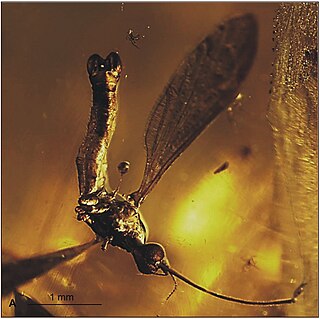
Elephantomyia (Elephantomyia) bozenae is an extinct species of crane fly in the family Limoniidae. The species is solely known from the Middle Eocene Baltic amber deposits in the Baltic Sea region of Europe. The species is one of six described from Baltic amber.

Elephantomyia (Elephantomyia) irinae is an extinct species of crane fly in the family Limoniidae. The species is solely known from the Middle Eocene Baltic amber deposits in the Baltic Sea region of Europe. The species is one of six described from Baltic amber.
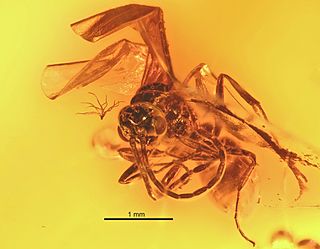
Pachycondyla succinea is an extinct species of ant in the formicid subfamily Ponerinae described from fossils found in Europe. P. petrosa is one of three middle Eocene Pachycondyla species found in Baltic amber.

Rovno amber, occasionally called Ukrainian amber, is amber found in the Rivne Oblast and surrounding regions of Ukraine and Belarus. The amber is dated between Late Eocene and Early Miocene, and suggested to be contemporaneous to Baltic amber. Major exploration and mining of the amber did not start until the 1990s.

Nylanderia pygmaea is an extinct species of formicid in the ant subfamily Formicinae known from fossils found in the Baltic region.

Gastrocoptidae is a family of minute, air-breathing land snails, terrestrial pulmonate gastropod molluscs in the superfamily Pupilloidea.















